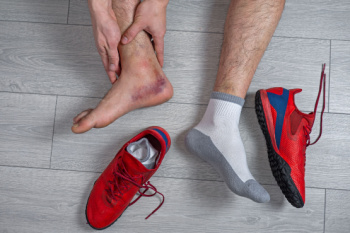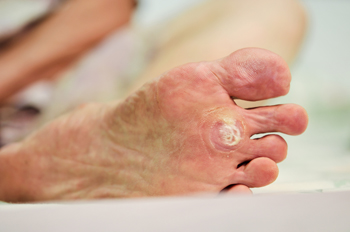Items filtered by date: August 2024
Understanding Seed Corns on the Foot

Seed corns on the foot are small, painful calluses that typically develop on the sole or between the toes. This condition arises from pressure and friction, often caused by wearing ill-fitting shoes or abnormal foot mechanics. Seed corns are characterized by a small, hard central core surrounded by inflamed skin. There are different types of corns, which are hard corns that form on the tops and sides of toes, soft corns, which appear between toes and are softer due to moisture, and seed corns, which are discrete, localized areas. To manage seed corns, it is important to wear comfortable, well-fitting shoes and use protective pads. Regular foot care and avoiding activities that put excessive pressure on the feet can help prevent these painful growths. If you have developed a corn on your foot, it is suggested that you visit a podiatrist who can identify what type of corn it is, and offer appropriate relief options.
Corns can make walking very painful and should be treated immediately. If you have questions regarding your feet and ankles, contact Dr. Kevin Davis of Davis Foot & Ankle Centers. Our doctor will treat your foot and ankle needs.
Corns: What Are They? And How Do You Get Rid of Them?
Corns are thickened areas on the skin that can become painful. They are caused by excessive pressure and friction on the skin. Corns press into the deeper layers of the skin and are usually round in shape.
Ways to Prevent Corns
There are many ways to get rid of painful corns such as:
- Wearing properly fitting shoes that have been measured by a professional
- Wearing shoes that are not sharply pointed or have high heels
- Wearing only shoes that offer support
Treating Corns
Although most corns slowly disappear when the friction or pressure stops, this isn’t always the case. Consult with your podiatrist to determine the best treatment option for your case of corns.
If you have any questions please feel free to contact our office located in Springfield, TN . We offer the newest diagnostic and treatment technologies for all your foot and ankle needs.
Types of Ankle Sprains

The talus, tibia, and fibula bones reside in the ankle and work together to facilitate movement of the foot in all directions. There are strong ligaments on the inside and outside of the ankle which bind and support these bones as well as the connection between the ankle and lower leg. When these ligaments become overly stretched or even torn during an injury, this is known as an ankle sprain. Ankle sprains are the most common form of ankle injury, and can occur when the ankle rolls outward or inward. Ankle sprains may cause pain ranging from mild to severe, swelling, decreased range of motion, and you may have limited or no ability to walk. Because improperly healed ankle sprains can lead to additional ankle sprains, chronic ankle instability, and even arthritis, it is suggested you schedule an appointment to visit a podiatrist to see if you have sprained your ankle. This type of doctor will be able to properly diagnose your condition and its severity, and treat it effectively.
Ankle sprains are common but need immediate attention. If you need your feet checked, contact Dr. Kevin Davis from Davis Foot & Ankle Centers. Our doctor can provide the care you need to keep you pain-free and on your feet.
How Does an Ankle Sprain Occur?
Ankle sprains take place when the ligaments in your ankle are torn or stretched beyond their limits. There are multiple ways that the ankle can become injured, including twisting or rolling over onto your ankle, putting undue stress on it, or causing trauma to the ankle itself.
What Are the Symptoms?
- Mild to moderate bruising
- Limited mobility
- Swelling
- Discoloration of the skin (depending on severity)
Preventing a Sprain
- Wearing appropriate shoes for the occasion
- Stretching before exercises and sports
- Knowing your limits
Treatment of a Sprain
Treatment of a sprain depends on the severity. Many times, people are told to rest and remain off their feet completely, while others are given an air cast. If the sprain is very severe, surgery may be required.
If you have suffered an ankle sprain previously, you may want to consider additional support such as a brace and regular exercises to strengthen the ankle.
If you have any questions please feel free to contact our office located in Springfield, TN . We offer the newest diagnostic and treatment technologies for all your foot and ankle needs.
Plantar Wart Treatment and Prevention
 Plantar warts, caused by the human papillomavirus, or HPV, appear on the soles of the feet and can be painful. Prevention focuses on minimizing exposure to the virus. Always wear footwear in communal areas such as locker rooms and pools, avoid sharing personal items like shoes and towels, and keep your feet clean and dry to reduce the risk of infection. Boosting your immune system through maintaining a healthy diet and regular exercise can also help. Treatment options vary based on the severity of the warts. Remedies like salicylic acid can effectively dissolve the wart over time. Cryotherapy, performed by a podiatrist, involves freezing the wart with liquid nitrogen, causing it to fall off. Laser treatment and immunotherapy are other professional options. For stubborn or painful warts, it is suggested that you consult a podiatrist.
Plantar warts, caused by the human papillomavirus, or HPV, appear on the soles of the feet and can be painful. Prevention focuses on minimizing exposure to the virus. Always wear footwear in communal areas such as locker rooms and pools, avoid sharing personal items like shoes and towels, and keep your feet clean and dry to reduce the risk of infection. Boosting your immune system through maintaining a healthy diet and regular exercise can also help. Treatment options vary based on the severity of the warts. Remedies like salicylic acid can effectively dissolve the wart over time. Cryotherapy, performed by a podiatrist, involves freezing the wart with liquid nitrogen, causing it to fall off. Laser treatment and immunotherapy are other professional options. For stubborn or painful warts, it is suggested that you consult a podiatrist.
Plantar warts can be very uncomfortable. If you need your feet checked, contact Dr. Kevin Davis from Davis Foot & Ankle Centers. Our doctor will assist you with all of your foot and ankle needs.
About Plantar Warts
Plantar warts are the result of HPV, or human papillomavirus, getting into open wounds on the feet. They are mostly found on the heels or balls of the feet.
While plantar warts are generally harmless, those experiencing excessive pain or those suffering from diabetes or a compromised immune system require immediate medical care. Plantar warts are easily diagnosed, usually through scraping off a bit of rough skin or by getting a biopsy.
Symptoms
- Lesions on the bottom of your feet, usually rough and grainy
- Hard or thick callused spots
- Wart seeds, which are small clotted blood vessels that look like little black spots
- Pain, discomfort, or tenderness of your feet when walking or standing
Treatment
- Freezing
- Electric tool removal
- Laser Treatment
- Topical Creams (prescription only)
- Over-the-counter medications
To help prevent developing plantar warts, avoid walking barefoot over abrasive surfaces that can cause cuts or wounds for HPV to get into. Avoiding direct contact with other warts, as well as not picking or rubbing existing warts, can help prevent the further spread of plantar warts. However, if you think you have developed plantar warts, speak to your podiatrist. He or she can diagnose the warts on your feet and recommend the appropriate treatment options.
If you have any questions please feel free to contact our office located in Springfield, TN . We offer the newest diagnostic and treatment technologies for all your foot and ankle needs.
Gout Pain Can Be Managed
Foot Pain Relief From Prolonged Standing
 Working on your feet all day can lead to significant foot pain, but there are several strategies to alleviate discomfort. Start by wearing supportive, well-fitted shoes with good arch support and cushioning to reduce strain on your feet. Custom orthotic inserts can provide additional support tailored to your foot's unique shape. Take regular breaks to sit down and rest your feet, even if it is just for a few minutes. Stretching exercises, such as calf stretches and toe flexes, can improve flexibility and reduce muscle tension. Incorporate foot massages and rolling your feet over a tennis ball to relieve pressure points and enhance circulation. Maintaining a healthy weight can reduce the stress on your feet. At the end of the day, elevate your feet to decrease swelling. If foot pain persists, it is suggested that you consult a podiatrist for a thorough evaluation and personalized treatment plan for more tips and to address any underlying issues.
Working on your feet all day can lead to significant foot pain, but there are several strategies to alleviate discomfort. Start by wearing supportive, well-fitted shoes with good arch support and cushioning to reduce strain on your feet. Custom orthotic inserts can provide additional support tailored to your foot's unique shape. Take regular breaks to sit down and rest your feet, even if it is just for a few minutes. Stretching exercises, such as calf stretches and toe flexes, can improve flexibility and reduce muscle tension. Incorporate foot massages and rolling your feet over a tennis ball to relieve pressure points and enhance circulation. Maintaining a healthy weight can reduce the stress on your feet. At the end of the day, elevate your feet to decrease swelling. If foot pain persists, it is suggested that you consult a podiatrist for a thorough evaluation and personalized treatment plan for more tips and to address any underlying issues.
While working on the feet, it is important to take the proper care of them. For more information about working on your feet, contact Dr. Kevin Davis from Davis Foot & Ankle Centers. Our doctor will treat your foot and ankle needs.
Working on Your Feet
Standing on your feet for long periods of time can cause stress and pain in your feet. Your whole body may experience change in terms of posture, back pain, bunions, callouses and or plantar warts. There are ways to avoid these conditions with proper foot care, smart choices and correct posture.
Positive Changes
Negative heeled shoe – Choosing this shoe type places the heel slightly lower than the ball of the foot. These are great for overall foot health. Find shoes that fit you correctly.
Go barefoot – Our feet were not designed to be enclosed for all hours of the day. Try to periodically expose your feet to air.
Eliminate Pain
Foot Exercises – Performing simple exercises, incorporating yoga and doing stretches are beneficial. This will allow increased blood flow to the area and muscles of the foot.
Achilles tendon – Stretching the foot out flat on the floor will relax the calf muscles and tendon. These exercises can be performed almost anywhere. Make sure you add these exercises to your daily regimen.
With a little bit of this information and knowing more about foot health, you will notice changes. Foot stretches and proper footwear will help with pain and prevent further issues.
If you have any questions please feel free to contact our office located in Springfield, TN . We offer the newest diagnostic and treatment technologies for all your foot and ankle needs.

